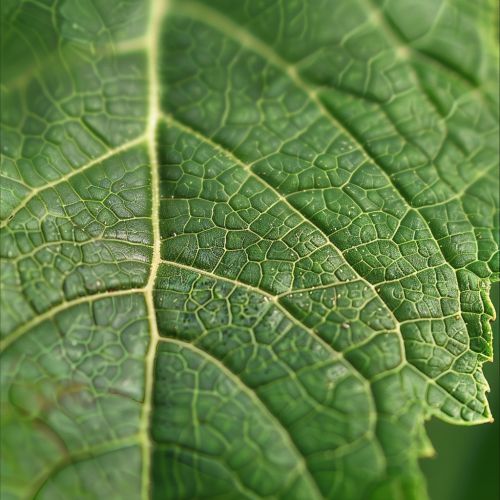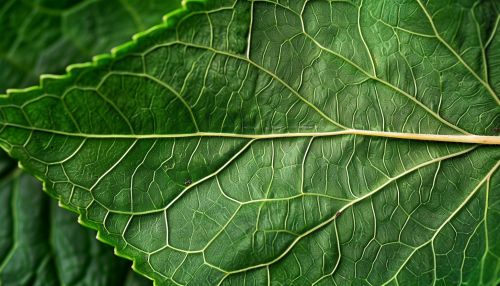Leaf
Introduction
A leaf is a principal organ of a vascular plant and is typically the primary site of photosynthesis. Leaves are also involved in gas exchange and transpiration. Their structure, function, and adaptations are critical to the survival and growth of plants. This article delves into the anatomy, physiology, types, and ecological significance of leaves.
Anatomy of a Leaf
The anatomy of a leaf is complex and consists of several layers, each with specific functions.
Epidermis
The epidermis is the outermost layer of cells covering the leaf. It serves as a protective barrier against physical damage and pathogens. The epidermis is typically covered with a waxy cuticle that reduces water loss. Stomata, small openings in the epidermis, facilitate gas exchange and are regulated by guard cells.
Mesophyll
The mesophyll is the inner tissue of the leaf, sandwiched between the upper and lower epidermis. It is divided into two layers:
- **Palisade Mesophyll**: Located beneath the upper epidermis, it consists of tightly packed cells rich in chloroplasts, making it the primary site of photosynthesis.
- **Spongy Mesophyll**: Located below the palisade layer, it contains loosely arranged cells with air spaces to facilitate gas exchange.
Vascular Bundles
Vascular bundles, also known as veins, are embedded within the mesophyll. They consist of xylem and phloem tissues:
- **Xylem**: Transports water and minerals from the roots to the leaves.
- **Phloem**: Transports the products of photosynthesis from the leaves to other parts of the plant.


Physiology of Leaves
Leaves play a crucial role in various physiological processes essential for plant survival.
Photosynthesis
Photosynthesis is the process by which leaves convert light energy into chemical energy. It occurs in the chloroplasts, primarily within the palisade mesophyll. The general equation for photosynthesis is:
\[ 6CO_2 + 6H_2O + light \ energy \rightarrow C_6H_{12}O_6 + 6O_2 \]
Transpiration
Transpiration is the process of water vapor loss from the leaf surface through stomata. It helps in cooling the plant, maintaining nutrient flow, and driving the uptake of water from the roots.
Gas Exchange
Leaves facilitate gas exchange through stomata. Carbon dioxide enters the leaf, and oxygen, a byproduct of photosynthesis, exits. This exchange is vital for photosynthesis and respiration.
Types of Leaves
Leaves vary widely in shape, size, and structure, adapted to different environments and functions.
Simple and Compound Leaves
- **Simple Leaves**: Have a single, undivided blade. Examples include oak and maple leaves.
- **Compound Leaves**: Have a blade divided into multiple leaflets. Examples include the leaves of ferns and acacias.
Leaf Venation
Leaf venation refers to the pattern of veins in a leaf. There are several types:
- **Parallel Venation**: Veins run parallel to each other, typical in monocots like grasses.
- **Reticulate Venation**: Veins form a network, common in dicots like roses.
Leaf Arrangement
The arrangement of leaves on a stem can be:
- **Alternate**: One leaf per node, alternating sides.
- **Opposite**: Two leaves per node, directly opposite each other.
- **Whorled**: Three or more leaves per node, arranged in a circle.
Ecological Significance of Leaves
Leaves are integral to the ecosystem, providing food, oxygen, and habitat.
Primary Producers
As primary producers, leaves are the foundation of the food chain. They convert solar energy into chemical energy, which is then consumed by herbivores and higher trophic levels.
Oxygen Production
Through photosynthesis, leaves produce oxygen, essential for the survival of aerobic organisms.
Habitat and Microclimate
Leaves create microhabitats for various organisms, including insects, birds, and microorganisms. They also influence the microclimate by providing shade and reducing temperature fluctuations.
Adaptations of Leaves
Leaves exhibit various adaptations to survive in different environments.
Xerophytic Adaptations
Xerophytes are plants adapted to dry environments. Their leaves may have:
- Thick cuticles to reduce water loss.
- Sunken stomata to minimize transpiration.
- Reduced leaf surface area to limit water loss.
Hydrophytic Adaptations
Hydrophytes are plants adapted to aquatic environments. Their leaves may have:
- Large air spaces for buoyancy.
- Thin cuticles as water loss is not a concern.
- Stomata on the upper surface to facilitate gas exchange.
Mesophytic Adaptations
Mesophytes are plants adapted to environments with moderate water availability. Their leaves typically have:
- Well-developed vascular tissues for efficient water and nutrient transport.
- Balanced stomatal distribution for optimal gas exchange and transpiration.
